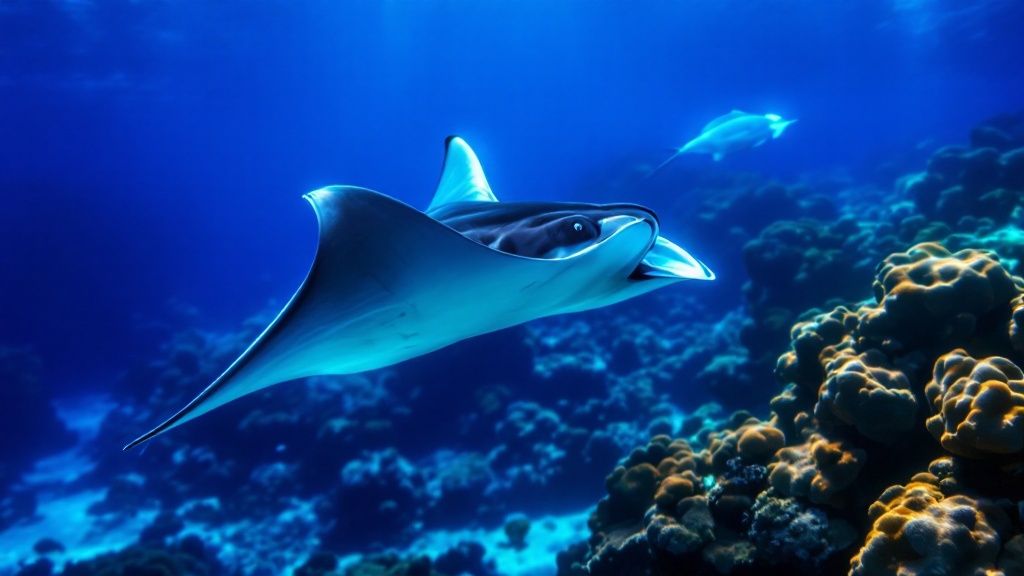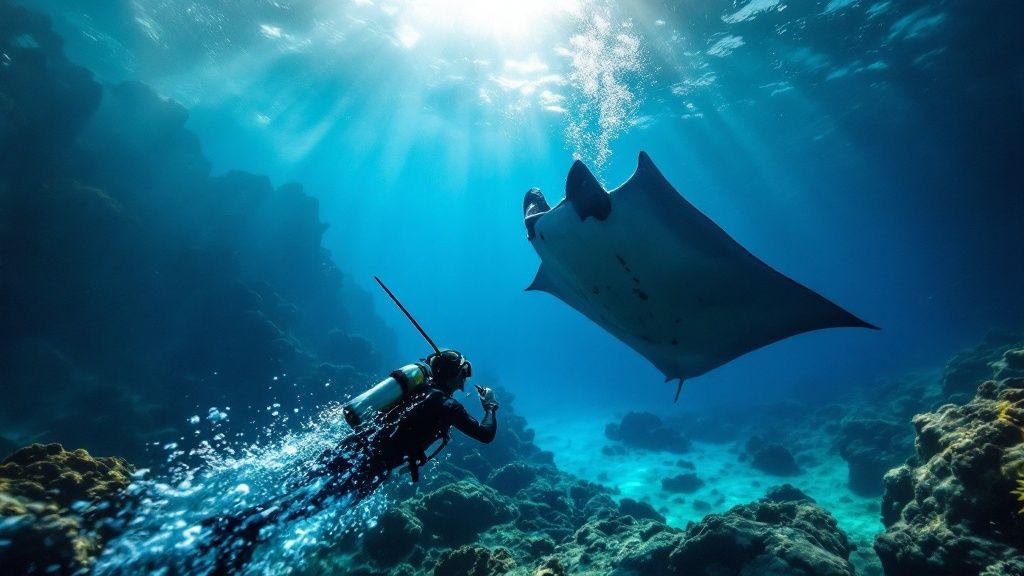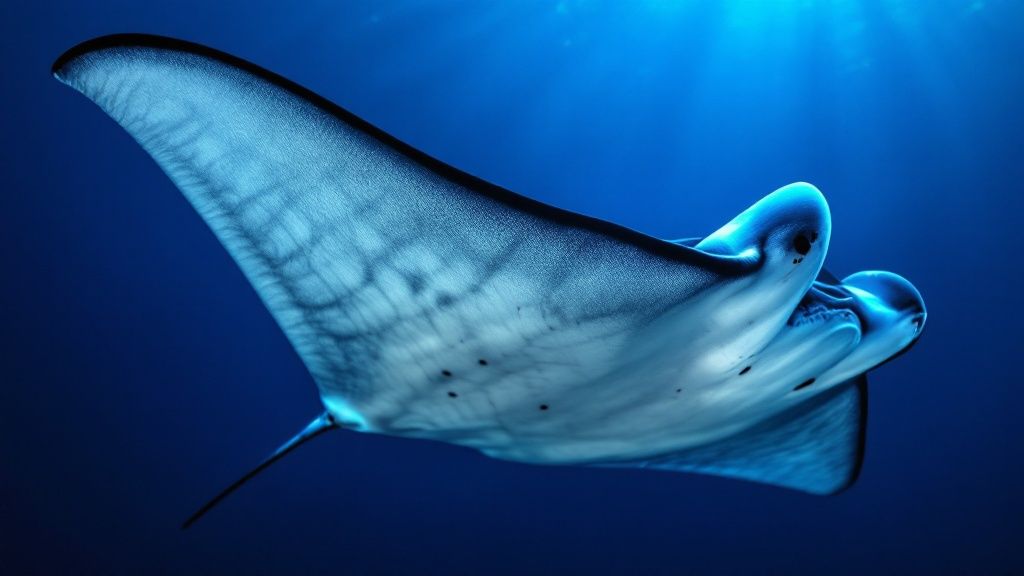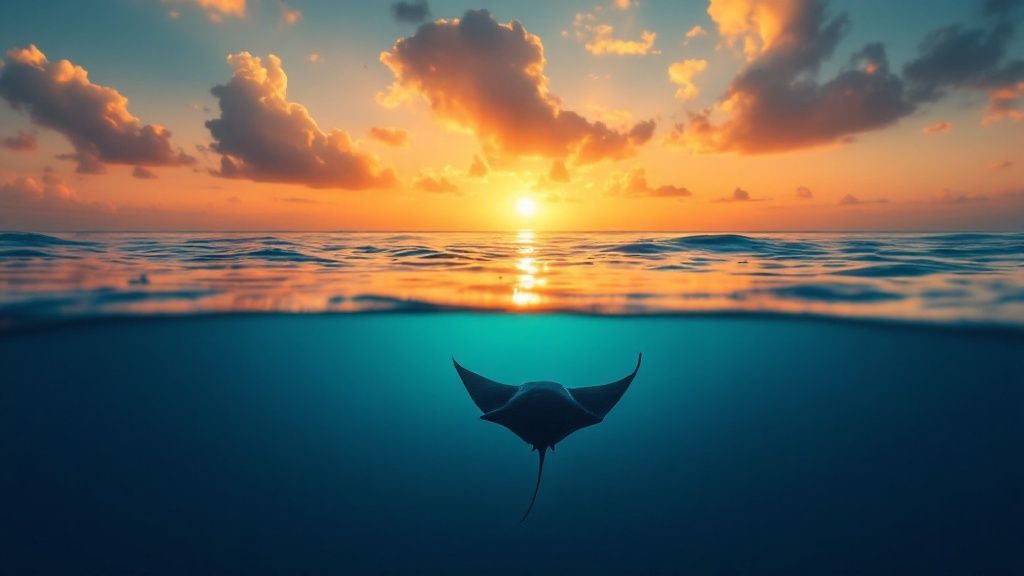Manta Ray Snorkel Kona: Epic Hawaiian Encounter
- Byron
- Apr 20
- 12 min read
Why Manta Ray Snorkel Kona Transforms Ordinary Travelers

The Kona coast of Hawaii offers more than just beautiful scenery; it's a gateway to an extraordinary underwater world. As the sun dips below the horizon, anticipation builds for a truly unique experience: a manta ray night snorkel. This isn't just another tourist activity; it's a profound encounter that connects you with the ocean on a deeper level.
The Kona Coast: A Manta Ray Sanctuary
Kona's special appeal for manta rays lies in the combination of volcanic landscape, nutrient-rich currents, and abundant plankton. Volcanic activity has sculpted a dramatic underwater terrain, while upwellings bring essential nutrients to the surface. This creates ideal conditions for plankton blooms, the manta rays' main food source.
This reliable food source ensures manta rays are present year-round. The remarkable success rate of manta ray snorkel tours, between 80 and 90%, underscores this abundance. Approximately 80,000 people participate in these tours annually, contributing significantly to the local economy. Learn more about these incredible encounters here.
A Transformative Encounter
Beyond the initial thrill of seeing these gentle giants, a manta ray snorkel in Kona offers a unique opportunity for personal growth. Imagine floating in darkness, then suddenly, underwater lights reveal a majestic manta ray. Its graceful movements, immense size, and peaceful demeanor evoke a sense of awe and wonder.
Hawaiian Cultural Significance
The experience is further enriched by the Hawaiian culture. Manta rays, revered as ‘aumākua (ancestral spirits), hold a special spiritual significance. This adds a profound dimension to the encounter, moving beyond typical wildlife tourism. It becomes a moment of connection not only with nature but also with the cultural heritage of Hawaii. This deep respect for the marine environment permeates the tours, enhancing the experience's authenticity.
Beyond Sightseeing: An Inspiring Call to Action
Witnessing these majestic creatures firsthand often sparks a sense of responsibility for ocean conservation. Many leave with a renewed appreciation for the delicate marine ecosystem and a desire to protect these animals. This transformative effect turns travelers into ocean advocates, dedicated to preserving these magnificent creatures for generations to come. A manta ray snorkel in Kona isn't just a trip; it's a journey of discovery and a catalyst for positive change.
Prime Manta Ray Encounters: Kona's Magical Locations

Kona, Hawaii isn't just a place to see manta rays; it's the place. But even within this special area, certain spots hold a particular magic. Experienced guides, familiar with the Kona coast, know exactly what makes these locations so exceptional. Let's delve into some of Kona's most renowned manta ray hotspots.
Manta Village and Manta Heaven: Where The Magic Happens
Two locations consistently top the list: Manta Village and Manta Heaven. These aren't just clever names; they reflect the remarkable manta ray activity at these sites. The unique underwater terrain, featuring volcanic rock formations and lava tubes, creates ideal feeding grounds.
Plankton, the main food source for manta rays, flourishes in these nutrient-rich waters. This abundance of plankton attracts these gentle giants night after night. The Kona Coast is famous for frequent manta ray sightings. From 2009 to 2014, underwater videographers at Manta Village and Manta Heaven diligently tracked manta ray activity, compiling comprehensive monthly data. This ongoing research helps conservation efforts and makes these snorkeling experiences even more predictable. For more detailed statistics, visit Manta Ray Advocates.
Beyond The Famous: Hidden Gems For Intimate Encounters
While Manta Village and Manta Heaven offer reliable sightings, Kona also has lesser-known spots perfect for a more intimate experience. These hidden gems are often revealed by local guides who have spent countless hours exploring these waters.
They offer a chance to observe manta rays away from the crowds. This provides a unique perspective and a deeper connection with these magnificent creatures. For more information and location insights, check out our sitemap.
Choosing The Right Spot: Finding Your Perfect Manta Ray Experience
Each manta ray viewing location offers its own unique advantages. Some are easily accessible from the shore, perfect for independent snorkelers. Others are best reached by boat tours, offering a more structured experience.
Water conditions also vary. Some locations have calmer waters and better visibility than others. This variety ensures a perfect spot for everyone, from first-time snorkelers to experienced underwater photographers.
To help you choose the perfect location, we've compiled a comparison of the top manta ray snorkeling spots in Kona:
Top Manta Ray Snorkeling Locations in Kona
Comparison of the main manta ray snorkeling spots around Kona with key features and best times to visit
Location | Success Rate | Best Time | Accessibility | Crowd Level | Special Features |
|---|---|---|---|---|---|
Manta Village | High | Sunset-Night | Boat | High | Established viewing platform |
Manta Heaven | High | Sunset-Night | Boat | High | Calm waters |
Keauhou Bay | Moderate | Sunset-Night | Shore/Boat | Moderate | Close to shore |
Garden Eel Cove | Moderate | Sunset-Night | Boat | Low | Diverse marine life |
Makako Bay | Low | Daytime | Shore/Boat | Low | Secluded location |
This table highlights key features to consider when choosing your snorkeling spot. Factors like accessibility, crowd levels, and special features can greatly influence your overall experience.
By understanding these nuances and researching each location, you can maximize your chances of an unforgettable manta ray encounter. For further planning resources, check out this page.
Timing Your Manta Magic: Seasonal Insights For Success

While Kona boasts year-round manta ray sightings, understanding the seasonal nuances can greatly enhance your manta ray snorkel Kona adventure. This means looking beyond the generic "always great" and delving into the specifics for a truly unforgettable encounter.
Seasonal Currents And Plankton: The Manta Buffet
Ocean currents shift throughout the year, impacting plankton concentrations, water visibility, and manta ray feeding habits. During the summer months (April-October), calmer waters and increased sunlight generally lead to larger plankton blooms. This, in turn, attracts more manta rays, making sightings highly likely.
However, this period also coincides with peak tourist season, meaning larger crowds. While sightings are practically guaranteed, your experience might feel less personal. When planning, consider that other locations, such as those around Marathon Key Snorkeling, also offer diverse and beautiful snorkeling experiences.
Off-Season Advantages: A Different Kind Of Magic
The off-season (November-March) offers unique advantages. Fewer crowds translate to a more personalized experience, often allowing for closer manta ray interactions. While large plankton blooms might be less frequent, mantas display different feeding behaviors during these months, providing a fascinating glimpse into their natural habits.
Detailed sighting statistics from Kona's 'Manta Heaven' and 'Manta Village' offer valuable insights into these magnificent creatures. For example, data from 2013 meticulously tracked the total number of individual manta rays sighted during night dives each month. This kind of detailed data collection is crucial for both understanding manta ray behavior and contributing to their conservation. More detailed statistics can be found here.
Moon Phases, Tides, And The Plankton Feast
Beyond seasonal variations, the interplay of moon phases and tides also significantly influences plankton availability. A full moon, for instance, can intensify plankton blooms, creating a feeding frenzy for manta rays. Understanding these subtle but powerful factors helps you perfectly time your manta ray snorkel Kona trip for optimal viewing.
For additional planning tips and insights to maximize your manta ray encounter, explore more of our blog posts through our sitemap.
Choosing Your Ideal Time: Balancing Factors
The best time for your manta ray snorkel Kona adventure ultimately depends on your priorities. Do you prefer guaranteed sightings even with larger crowds, or a quieter, more intimate encounter? By weighing these considerations and understanding the seasonal nuances, you can strategically plan your trip to match your preferences and experience the ultimate manta magic.
To help you decide, take a look at the table below:
Monthly Manta Ray Sighting Statistics in Kona Statistical breakdown of manta ray sightings throughout the year based on historical data
Month | Average Number of Mantas | Visibility Conditions | Water Temperature | Crowd Level | Recommendation Rating |
|---|---|---|---|---|---|
January | 10-15 | Moderate | 75-78°F | Low | 4/5 |
February | 12-18 | Good | 74-77°F | Low | 4.5/5 |
March | 15-20 | Excellent | 76-79°F | Medium | 4/5 |
April | 18-25 | Excellent | 78-81°F | Medium | 4.5/5 |
May | 20-30 | Excellent | 79-82°F | High | 4/5 |
June | 25-35 | Good | 80-84°F | High | 4/5 |
July | 25-35 | Good | 81-85°F | High | 3.5/5 |
August | 20-30 | Moderate | 82-86°F | High | 3.5/5 |
September | 15-25 | Moderate | 81-84°F | Medium | 4/5 |
October | 12-20 | Good | 79-82°F | Medium | 4.5/5 |
November | 10-15 | Excellent | 77-80°F | Low | 4/5 |
December | 8-12 | Good | 75-78°F | Low | 4/5 |
The table above provides a general overview of manta ray sighting trends in Kona. As you can see, the best time for viewing, balancing manta numbers and crowd levels, is often during the shoulder seasons (April-May and September-October). However, the off-season months offer a more intimate experience for those who prioritize fewer crowds.
Selecting Your Perfect Manta Ray Snorkel Experience

Not all manta ray snorkel Kona tours are the same. The price is just one factor. Choosing the right tour operator can dramatically change your experience, turning a simple sighting into something truly special. This guide uses advice from marine biologists, experienced guides, and past snorkelers to help you pick the perfect tour.
Key Questions To Ask: Understanding a Tour Operator's Dedication
Asking the right questions before you book can show you how dedicated a tour operator is to both happy customers and protecting the ocean. For example, ask about their group sizes. Smaller groups often offer a more personal experience, allowing for better interaction with the manta rays and more attention from the guides.
Also, ask about the guides' experience and qualifications. Knowledgeable guides can enrich your trip by sharing insights into manta ray behavior, how to identify them, and the local ecosystem. This transforms quick glimpses into a learning adventure. Don't forget about the boat itself. A comfortable boat with easy water access and the right safety equipment significantly adds to the overall enjoyment.
Beyond the Basics: Important Details That Elevate Your Experience
Some less obvious things can greatly affect your manta ray snorkel Kona adventure. The positioning techniques used by the boat crew are critical. Skilled operators know how to position the boat and lighting to attract manta rays without disturbing them.
The lighting system is also crucial. Well-placed and controlled lights attract plankton, which then brings the manta rays closer to the surface, creating great viewing opportunities. Another factor is the staff-to-guest ratio. A higher ratio means more individual attention, improved safety, and more chances to ask questions.
Evaluating True Value: Looking Past the Marketing
When choosing a manta ray snorkel Kona tour, look beyond the marketing and assess the real value. Think about the operator's dedication to sustainable practices, their focus on educating guests, and how they support local conservation efforts.
You might find this helpful: How to master your Kona manta ray experience by exploring our blog category sitemap. This offers valuable information on what makes certain operators stand out and how to choose a tour that matches your values.
Making Informed Decisions: Checklist For Your Ideal Tour
Here's a checklist to help you decide:
Group Size: Smaller groups (10-15 people or fewer) are ideal.
Guide Expertise: Seek out certified guides with lots of manta ray knowledge.
Boat Features: Look for comfortable seating, easy water access, and proper safety equipment.
Positioning Techniques: Ask about how the operator attracts mantas without disturbing them.
Lighting System: Ask about the lights used and how they are positioned to attract plankton.
Staff-to-Guest Ratio: A higher ratio means better attention and safety.
Sustainability Practices: Choose operators dedicated to responsible tourism.
By thinking about these factors, you can pick a manta ray snorkel Kona tour that gives you the best chance of a truly magical experience. This careful approach ensures that you not only see these amazing creatures but also contribute to their well-being.
Mastering The Night: Preparation For Magical Encounters
Getting ready for your manta ray night snorkel in Kona is about turning any pre-trip jitters into pure excitement. This guide, created with experienced guides and marine safety experts, goes beyond the basics to help you fully embrace this incredible adventure.
Comfortable Night Snorkeling Techniques
Night snorkeling is a unique experience. A few simple techniques can make you feel much more comfortable in the water. Controlled breathing is key. Slow, deep breaths help you relax and conserve air. Maintaining a horizontal body position is also important. This minimizes disturbance to the manta rays and improves your visibility.
Addressing Common Concerns
First-time night snorkelers often have similar questions. Worried about seasickness? Over-the-counter medication or acupressure wristbands can help. Concerned about the dark? The underwater lights and the mesmerizing manta rays quickly dispel any fear. Staying warm is easily managed with a wetsuit or rash guard.
Underwater Photography Tips For Night Encounters
Capturing the magic of manta rays at night requires a little know-how. Adjust your camera's ISO and shutter speed to handle the low light. Position your lighting carefully to illuminate the manta rays without overwhelming them. Think about composition to showcase their size and elegance. If you'd rather fully experience the moment, some tour operators offer professional photography and videography packages, or a fellow snorkeler might share their footage.
Mental Preparation
Mental readiness is just as important as the physical aspects. Familiarize yourself with the snorkeling equipment beforehand. Practicing in a pool can build confidence. Visualizing the experience and focusing on the beauty of the manta rays can transform nervousness into excitement. For additional tips, check out our guide on how to master your Kona manta ray experience.
Essential Checklist For A Magical Night
Seasickness Prevention: Medication, acupressure bands
Warmth: Wetsuit or rash guard
Camera Settings: Adjust ISO and shutter speed for low light
Lighting: Position strategically for manta ray illumination
Mental Visualization: Focus on positive expectations
By addressing these points, you'll be fully prepared to embrace the magic of a manta ray snorkel Kona adventure. This thoughtful preparation sets the stage for a relaxed and enjoyable experience, allowing you to truly connect with these magnificent creatures.
Understanding Manta Behavior: Reading Their Ocean Language
The magic of a manta ray snorkel Kona experience goes beyond simply observing these graceful giants. It's about understanding their behavior and forging a deeper connection with them. Think of it like learning a new language – the language of the ocean, expressed through the mantas' movements and interactions.
Identifying Individual Mantas: Unique Belly Patterns
Just like our fingerprints, each manta ray possesses a unique pattern of spots on its belly. These distinct markings allow researchers and experienced guides to identify individual mantas, often giving them names. Learning to recognize these patterns helps you track individuals and appreciate the diversity within the manta ray population.
Decoding Feeding Techniques: From Barrel Rolls to Chain Feeding
Manta rays employ fascinating feeding techniques based on plankton concentration and water currents. Barrel rolling, where mantas spiral vertically through the water, filtering plankton, is a common sight. Chain feeding is another intriguing behavior where multiple mantas line up, creating an underwater conga line as they feast.
Social Interactions: Unveiling Their Complex Intelligence
Manta rays are highly social, exhibiting complex interactions that suggest intelligence. They often engage in playful behavior, sometimes seemingly interacting with snorkelers out of curiosity. Observing these interactions provides valuable insights into their social dynamics and communication methods.
Body Language: Communicating Without Words
Mantas communicate using subtle body language and fin movements. A cephalic fin salute, where the manta curls its cephalic fins inward, may indicate curiosity or a friendly greeting. Rapid changes in direction or sudden dives could signal discomfort or a desire to avoid interaction.
Movement Patterns and Comfort Levels
Understanding manta ray movement is crucial for responsible snorkeling. Slow, graceful gliding indicates a relaxed manta. However, if a manta displays erratic movements or tries to move away, it's important to give it space and avoid pursuit. This ensures the manta’s well-being and allows it to continue its natural behaviors undisturbed. This deeper understanding transforms passive observation into a meaningful connection, enriching your Kona manta ray snorkel adventure.
Being Part of the Solution: Ethical Manta Ray Encounters
Your manta ray snorkel Kona experience isn't just about creating personal memories; it's about contributing to the future of these vulnerable animals. Thoughtful tourism plays a crucial role in protecting manta ray populations against global threats.
Minimizing Disturbance, Maximizing Your Experience
Ethical interactions ensure both a rewarding experience for you and the well-being of the manta rays. Simple adjustments in your snorkeling behavior can make a world of difference. For example, avoid touching or chasing the manta rays.
Their delicate mucous layer protects them from disease, and physical contact can disrupt this vital defense mechanism. Maintaining a respectful distance allows you to observe their natural behavior without causing stress. This means no sudden movements or loud noises.
Remember, you are a visitor in their underwater world. For more tips, check out this helpful resource: How to master your manta ray experience. It offers valuable insights into respecting these gentle giants.
Citizen Science: Contributing to Conservation
Many operators incorporate citizen science programs into their tours. This means you can contribute valuable data during your snorkel. By taking photos of the manta rays' unique belly patterns, you can help researchers track individual animals and monitor the population.
This hands-on involvement transforms your experience from passive observation to active participation in manta ray conservation. You become a part of the solution, helping to safeguard these magnificent creatures for future generations.
Choosing Wisely: The Power of Your Choices
The tour operator you select speaks volumes about your values. Choosing operators committed to sustainable practices and conservation initiatives reinforces the importance of responsible tourism.
By supporting ethical businesses, you encourage others to follow suit, creating a positive ripple effect throughout the industry. Your choice empowers positive change.
Local Initiatives: Making a Measurable Difference
Several local initiatives are working tirelessly to protect manta rays in Kona. These programs focus on research, education, and advocacy, all essential for long-term conservation.
Learning about these efforts and supporting them through donations or volunteer work further amplifies your positive impact. You become an active participant in preserving the delicate balance of the marine ecosystem.
Guidelines for Ethical Manta Ray Encounters:
Maintain a Safe Distance: Stay at least 10 feet away from the manta rays.
No Touching: Avoid any physical contact with the manta rays.
No Chasing: Allow the manta rays to move freely and naturally.
Respect Their Space: If a manta ray shows signs of discomfort, give it space.
Support Responsible Operators: Choose tour companies committed to sustainable practices.
Participate in Citizen Science: Contribute to research by taking photos of manta ray bellies.
Minimize Your Environmental Impact: Use reef-safe sunscreen and reduce your plastic consumption.
By following these guidelines, you can ensure your manta ray snorkel Kona experience is both unforgettable and contributes to the conservation of these magnificent creatures. Book your Manta Ray Night Snorkel Kona Hawaii Tours today and experience the magic while supporting sustainable practices.
Comments